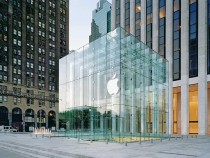
© Roy Zipstein
Modern technology has opened the way to ever more transparent facades, to a vision of light, almost dematerialised architecture. Glass is increasingly being used for load- bearing functions. But whatever the actual load-bearing frame, there are a number of fundamental principles to be observed when building with glass. Base glass can be produced in a wide range of types, to meet differing aesthetic and structural requirements. Soda-lime glass is the most common, which for architectural applications is available as float glass, rolled glass, profiled glass and glass blocks. For structural glazing the most important of these is float
glass. Before a standard-size (6.00 x 3.21 m) float glass product is used in building, coatings are applied (solar-screening, thermal, reflective/anti-reflective or dirt-repellent), then the glass is shaped, the edges finished and any holes drilled. Because glass is brittle and does not deform easily, it cannot take up local peak stresses. When limits are exceeded, spontaneous fracture can occur. To make it more “stable” therefore, it is often subjected to heat treatment, i.e. heated up to beyond the softening point and then rapidly cooled. This creates a state of natural tension in the glass, with tensile stresses inside the glass and compressive stresses on the surfaces.
Toughened and heat-strengthened glass is produced in this way.
glass. Before a standard-size (6.00 x 3.21 m) float glass product is used in building, coatings are applied (solar-screening, thermal, reflective/anti-reflective or dirt-repellent), then the glass is shaped, the edges finished and any holes drilled. Because glass is brittle and does not deform easily, it cannot take up local peak stresses. When limits are exceeded, spontaneous fracture can occur. To make it more “stable” therefore, it is often subjected to heat treatment, i.e. heated up to beyond the softening point and then rapidly cooled. This creates a state of natural tension in the glass, with tensile stresses inside the glass and compressive stresses on the surfaces.
Toughened and heat-strengthened glass is produced in this way.



